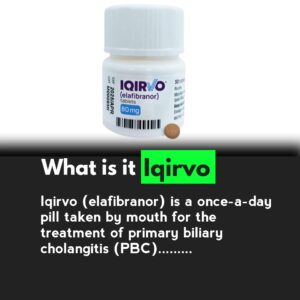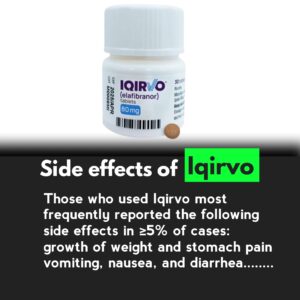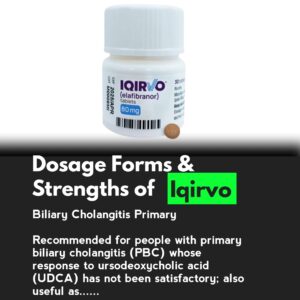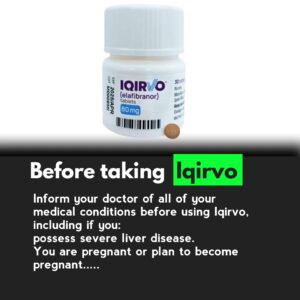what is it, Iqirvo?

Elafibranor, also known as Iqirvo, is a once-daily oral medication used to treat primary biliary cholangitis (PBC). It is given either in combination with UDCA or as a monotherapy for those unable to tolerate the use of the latter in adults who haven’t responded well to ursodeoxycholic acid (UDCA) alone.
Iqirvo is not advised for those with advanced liver disease (decompensated cirrhosis), though, if they exhibit any of these symptoms. These symptoms can include vomiting blood that may resemble “coffee grounds,” black or bloody feces, disorientation, and an accumulation of fluid in the abdomen.
In addition to its principal active metabolite, Iqirvo functions as a strong agonist of the PPAR receptor. gether with its primary active metabolite, Iqirvo is a potent PPAR receptor-activated receptor (PPAR) agonist. It does so by targeting PPAR receptors, key regulators for maintaining energy homeostasis and metabolic function.
Inhibition of the production of bile acid by activation of PPAR-alpha and PAR-delta. However, the mechanism of action to treat PBC is yet to be determined, despite its effectiveness. June 10, 2024: Iqirvo received accelerated approval from the FDA, becoming the first new PBC treatment in almost a decade.
Iqirvo side effects

Those who used Iqirvo most frequently reported the following side effects in ≥5% of cases:
growth of weight and stomach pain
vomiting, nausea, and diarrhea.
dry mouth, constipation, and muscle aches
loss of weight, rash, bone fractures, and joint pain
stomach ache
GERD stands for gastroesophageal reflux disease.
vomiting, nausea, and diarrhea.
dry mouth, constipation, and muscle aches
loss of weight, rash, bone fractures, and joint pain
stomach ache
GERD stands for gastroesophageal reflux disease.
1-10%
8 percent to 10% Arthralgia
Constipation (8%).
Pain in the muscles (7%).
Breakage (6%).
Disorders related to gastric reflux (6%)
5% of people have dry mouth.
Loss of weight (5%).
Rash (5%)
Lightheadedness (≤5%)
Indigestion (≤5%)
Blood creatinine level rise (≤5%)
Anemia (less than 5%)
CPK rose to >3 times the ULN (4%)
Myalgia (4%).
Three percent have cholelithiasis.
Both CPK and myalgia (1%) rose.
Acute renal damage along with rhabdomyolysis (1%)
Dosage Forms & Strengths

Biliary Cholangitis Primary
Recommended for people with primary biliary cholangitis (PBC) whose response to ursodeoxycholic acid (UDCA) has not been satisfactory; also useful as monotherapy for patients who cannot tolerate UDCA
80 mg PO qDay
Changes in Dosage
- Acid sequestrants for bile
Elafibranor should be given at least four hours before or after bile acid sequestrant, or as far apart as is practical.
- impairment of the kidneys
Severe, moderate, or mild: No dosage modification is advised. - Hepatic dysfunction
Mild (Child-Pugh A): It is not advised to change the dosage.
Mild to severe (Child-Pugh Type B or Type C): If the patient’s liver damage becomes worse and becomes moderate or severe, think about stopping.
Decompensated cirrhosis (such as hepatic encephalopathy, variceal hemorrhage, or ascites): Use is not advised; safety and effectiveness are not proven.
Considerations for Dosing
- Restrictions on Use
It is not recommended for patients with ascites, variceal hemorrhage, or hepatic encephalopathy, or those who develop these conditions in decompensated cirrhosis. - Prior to starting
Check for myopathy or pain in the muscles.
Make sure that no pregnant women of reproductive potential are in your life.
Serious side effects and warnings
- Rhabdomyolysis, myopathy, and/or myalgia. Elevated muscle enzyme (creatine phosphokinase) in the blood, which is a sign of muscle damage and can induce myalgia, tenderness, or weakness, are possible side effects associated with treatment with Iqirvo. Your PCP ought to do blood tests to check for muscle issues, keeping in mind that you are taking.
- If your muscle pain gets worse or comes on suddenly, your doctor may run a test to check your CPK levels. Stop using Iqirvo and call your doctor at once if you have any of these signs that you may be absorbing methoxsalen through your skin.
- Severe muscle pain, unexplained muscle weakness or soreness, and dark red urine.
- Bone fractures: Iqirvo may increase your risk of bone fractures. Report any bone fractures, onset of pain or change in mobility to your healthcare provider.
- Liver problems: Iqirvo may result in abnormal liver blood test results.
- Tarry or black-colored stools; Bloody, pinkish-red, coffee-grounds-like material that you vomit up (vomit looks like “coffee grounds”); You have blood in your sweat or urine
- Some Iqirvo users have experienced allergic reactions. The side effects occurred two to thirty days after the medication was taken and included symptoms like rash, itching, difficulty breathing, and swelling of the lips, neck, face, or tongue.If you have any of these side effects, stop taking Iqirvo and contact your doctor or the emergency room of the closest hospital right away.
- You run a higher risk of gallstone development and bile duct obstruction if you use Iqirvo. If you experience any gallstone-related signs or symptoms, such as upper right stomach pain or skin discoloration, immediately contact your healthcare professional.
If you experience any of the following symptoms while taking Iqirvo and they are severe, notify your doctor right away.
- weakness in the abdomen’s discomfort area
diarrhea, vomiting, chills, and fever
appetite loss or weight loss dizziness lightheadedness fresh or intensifying exhaustion less frequent urine.
- Might be harmful to a fetus. Before you take Iqirvo, your healthcare provider may perform a pregnancy test if you are a female who can become pregnant. If your liver test results become worse, or if the level of a blood enzyme related to muscle activity called creatine phosphokinase (CPK) is elevated on repeated tests during Iqirvo treatment, you may be told to stop taking Iqirvo temporarily or permanently.
If you have questions about side effects, call your doctor.
Related drugs
Before taking

Inform your doctor of all of your medical conditions before using Iqirvo, including if you:
possess severe liver disease.
You are pregnant or plan to become pregnant.
You are pregnant or plan to become pregnant.
Before you begin taking Iqirvo, your doctor should examine you for muscle weakness or soreness. Inform your healthcare practitioner without delay if you experience any recent, severe, or aching muscles or weakness.
Iqirvo’s safety and efficacy in children under the age of eighteen are unknown.
Pregnancy
- Iqirvo may be harmful to your fetus. Pregnancy should not occur while receiving therapy. Effective contraception is required for women of childbearing potential* from the start of treatment and should also be used throughout therapy up to 3 weeks after their last dose with Iqirvo. Talk to your physician about the birth control method that is best for you.
- Simply call your doctor if you get pregnant while taking Iqirvo. immediately. There is a pregnancy safety registry that monitors how this prescription affects you and your developing baby if you are a female and become pregnant while taking Iqirvo.
Breastfeeding
- If Iqirvo enters your breast milk, that information is unknown. For three weeks following the previous dosage and while on Iqirvo, do not breastfeed. If you take Iqirvo, discuss with your doctor the best way to feed your child.
How should I take Iqirvo?
- As directed by your healthcare specialist, take Iqirvo exactly as prescribed.
- The recommended dosage for Iqirvo is 80 mg once daily.
- You can take Iqirvo with or without food.
- Take Iqirvo at least 4 hours before or 4 hours after taking a bile acid-binding resin (such as cholestyramine or colestipol) if you take one.
- If this is not feasible, try to give yourself as much space as possible between taking Iqirvo and your bile acid-binding resin.
Your healthcare practitioner will monitor your liver function while you are being treated with Iqirvo and may change or terminate treatment if you have evidence of liver toxicity or decompensated cirrhosis
What happens if I overdose?
Assuming excess is thought, contact your medical services proficient or crisis clinical benefits immediately
What happens if I miss a dose?
If it is almost time for your next dose, skip the missed asenapine and return to your regular dosing schedule. Take the missed dose as soon as you remember but skip it if your next scheduled dose is about the same time.
What other drugs will affect Iqirvo?
Tell your doctor about all your current medicines and any medicine you start or stop using.
Tell your doctor, in particular, if you take:
birth control tablets, or hormonal contraceptives. When using hormonal contraceptives and for three weeks after the last dose of Iqirvo HMG-CoA reductase inhibitors, statins such as atorvastatin, pravastatin, or lipostatin must change to an effective non-hormonal contraceptive or add a barrier technique. Your health care professional should monitor for signs that you have developed a muscle injury.
Rifampin. If you start taking rifampin during treatment with IQIRVO, your healthcare provider should monitor liver enzymes such as bilirubin and alkaline phosphatase, as well as bile acid sequestrants like colestipol or cholestyramine. Iqirvo should be taken as far apart as possible, ideally 4 hours before or 4 hours after a bile acid-binding sequestrant.
The interactions listed here are not all-inclusive. For a complete list, check the Iqirvo Package Insert or speak with your healthcare professional.
Storage
Store the bottle and carton in their original packaging at room temperature between 15 and 30 °C (59 and 86 °F), Keep them away from light & moisture. Keep it out of the reach of children.

1 thought on “Iqirvo: The Complete Guide to Its Uses, Benefits, and Side Effects”